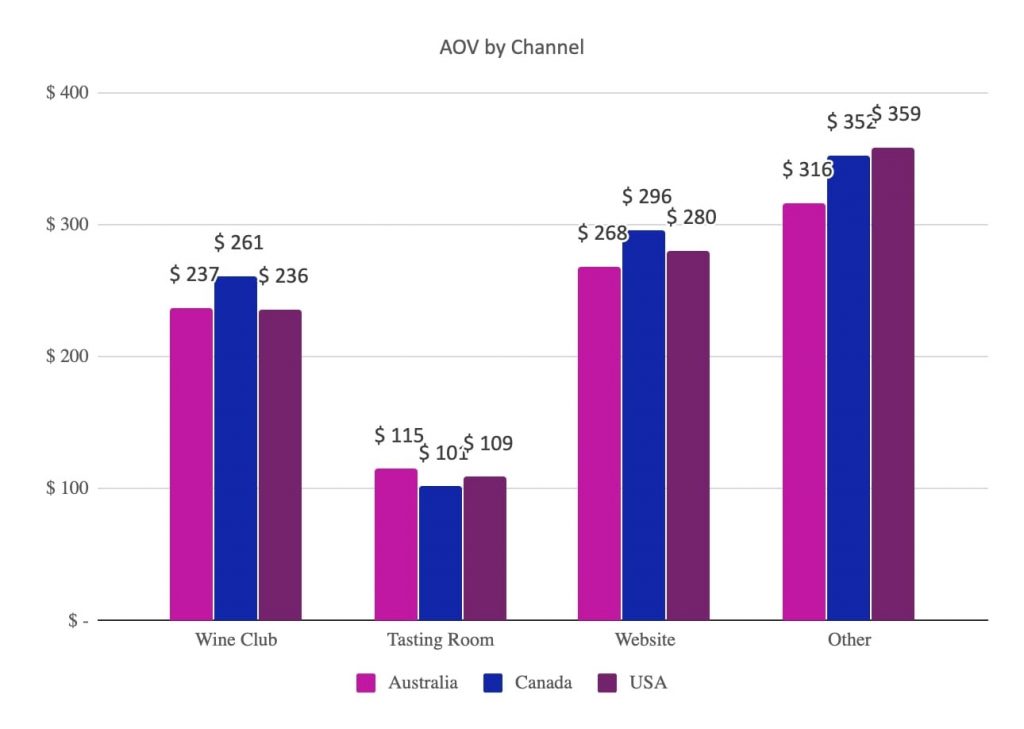So you’ve set your mind on starting an online business. You’ve done your research on how to pick winning products to sell online, read our ultimate step-by-step guide on how to start an e-commerce business, and a brilliant idea crossed your mind – starting a wine business online!
According to 2019 WineDirect DTC Report, a typical winery generates income from the following channels:
- About 36% of income comes as direct-to-consumer revenue through wine clubs,
- 34% at the point of sale in winery tasting rooms and at winery events,
- 20% from subscription, telephone, corporate and private-tasting orders,
- And (only) 10% online.
Wine e-commerce is the smallest yet the most promising niche due to its high average order value (AOV). Website wine orders may be the lowest revenue source for many wineries, but they average up to $300 in the US, Canada, and Australia, which is significantly higher in comparison to other channels.

These figures make online wine store worth investing in, especially now that the social events are still on hold. So sit back, relax (possibly with a glass of chardonnay), and enjoy this long-read about how to start an online wine business.
Launching an Online Wine Store: Where to Start With
Starting an online wine store basically means entering the online food market, so the first steps to transfer your business online are similar:
- identify your niche
- conduct market research
- analyze wine trends
- set up wine production and shipping
- get to know the laws of a state/country where you plan to sell.
For these and many other useful insights, take a glance at our article on how to sell food online.
Having chosen to sell wine online, you should identify your target audience, competitors, and common market trends. Ask yourself: who is my client? What are their interests, tastes, and habits? Can I offer something my competitors can’t? You may choose to sell vintage, premium wines ranging from $20 to $200+ per bottle and, thus, cater to the whims of upper-class clients. Or you may target the average millennials who buy wine on the go and won’t go higher than $12 per bottle.
According to the US 2019 Wine Market Council report, 49% of legal drinking population prefers wine: 14% of them drink wine more than once a week and 35% are occasional wine drinkers. Statistics show a slightly higher percentage of women buying wine (54%) in comparison to men (46%), and the baby boomers and Millenials occupy the biggest share of the wine market (34% each).

Whatever your customers’ profile, it will guide your choice of a website design and online marketing strategies, so market analysis is what you have to start with.
Targeting the Right Audience: How Do I Engage a Wine Consumer Online?
The chance to sell a bottle of wine in a wine tasting room has dropped to little more than zero in 2020, so finding ways to interact with customers online seems like the only way to stand out. Here’s what you can do:
Follow the Trends
The US consumer is now more concerned with health and wellness, and many spirit brands are introducing new low-alcohol, low-calorie drinks. The wine industry has been rather slow in responding to this, and, frankly speaking, there is hardly any sense in reducing the amount of alcohol or calories in a bottle of wine artificially. The US Department of Agriculture’s national nutrient database shows that a 5-ounce glass of red table wine – like Cabernet Sauvignon or Pinot Noir – typically contains less than 1 gram of sugar, so low-calorie wines are just like many other on the market.
VineSpring 2020 Wine Report explains why Millennials and Gen Z look out on alcohol in their body-positive movement:
“A glance at White Claw’s packaging alone lets millennials know the calorie count, a lesser alcohol content than wine (which health-conscious millennials like), gluten-free, number of carbs, and contains “natural flavors.” While wine might be one of the most “natural” beverages out there, few wineries are communicating these benefits.”
Labeling natural ingredients and outlining the advantages of wine might actually boost your sales and customers’ interest in your online wine business.
Take Advantage of Online Tools
According to Silicon Valley Bank report,
“Few wineries have an online presence that engages the customer. Sites lack sophisticated, responsive, fully integrated designs and experiences that allow new and returning customers frictionless e-commerce.”
Integrating online tools and plugins will not only jazz up your online store but also strengthen your direct-to-consumer (D2C) sales channel.
Creating a virtual winetasting room to increase traffic to your website is proven useful for an online wine store. Company representatives at Winc reported the online wine club led to a 798% increase in new member sign-ups between March 15 and April 4, 2020, as compared to the previous three-week period.
Another idea would be to provide a wine rating platform to collect drinker reviews, give wine appraisals, or consult the clients on your wine selection via chat. Overall, use your imagination and establish a strong online presence to woo your client.
Offer Flexible Shipping Policies and Incentives for Online Wine Purchases
Online wine store offers you a chance to boost D2C wine sales channel, which generated $3.1 billion in 2017 and is projected to reach $5.2 billion by 2022. Sounds impressive, right? All you have to do it to incentivize this channel once your online wine shop is launched, and here are a few ideas on how to do it:
- Provide free or flat-rate shipping based on your wine business model – on all orders, to first-time clients only, limited in time, or restricted to a certain country.
- Send loyal clients coupons and offer exclusive sales.
- Give your clients discounts on wines they have previously bought or create wine affiliate programs.
Do not be afraid to introduce discounts or lose money on shipping: flexible delivery services convince about 65% of customers to make a purchase, which later translates into higher rates of customer retention and, therefore, more sales.
Getting Your Papers Done: How to Get a License to Sell Wine Online
Bureaucracy related to launching an online wine store is probably one of the only reasons why wine e-commerce is still on the low. A wine producer has to go through much red tape and obtain a few permits, which vary not only from one country to another but also between states.
Here are a few things you should know about how to sell wine online legally:
How to sell wine online in the US
The required permit to sell wine online depends on the state and usually comes along with the Alcohol Dealer Registration, a state winery license, and a state retailer’s license. For instance, in California, as of January 1, 2012, an ABC type 85 limited off-sale retail wine license is required, which permits selling wine through D2C channels.
On the contrary, such states as Alabama, Utah, and Delaware prohibit shipping alcohol directly to households, so the winemaker can obtain in-store wine-selling licenses only. Here’s a map with states that have (or have no) specific license for alcohol shipping: The map of states allowing D2C alcohol shipments. Source: Wine Spectator.
How to sell wine online in Canada
Just like in the US, rules about selling alcohol online vary from one province to another. Any Canadian winery must have Manufacturer’s license obtained at the Liquor Control Board of their province, Licensee Retail Store and Wine Store licenses to sell liquor in-store by the bottle, and a few liquor permits. Ontario, Québec, Saskatchewan, and British Columbia are few provinces that currently allow in-person delivery of spirits.
How to sell wine online in Australia
Selling wine online is possible after obtaining a liquor license from the Office of Liquor and Gaming in a state where your business is located. The application form is filled out online and, once your good standing is checked, you’re all set to ship in-state and across the country. In fact, online alcohol purchases have been so successful in 2020 that some Australian online retailers report 50% to 500% increases in sales compared to the same period in 2019.
Building a Perfect Wine Selling Website
To create your online wine store, wineries often choose already established marketplaces, like WineDirect, VineSpring, or Shopify. These options indeed save time and energy for a wine seller to design a winery storefront; yet, this comes at the expense of unique design due to the predetermined website templates.
If you want to transfer the look and feel of your winery online, designing an original and unique ecommerce website is your only option. Magento Commerce is a great tool to fulfill this idea. Its feature-rich, user-friendly interface will allow you to place up to 500,000 items on the website and complete thousands of financial translations without overwhelming your client. Its limitless customization features will please the eye and gladden the heart of your customer, allowing you to integrate a third-party extension for a wine live chat or adapt your online store to mobile devices.
The costs for building a Magento eCommerce wine selling website vary from $50 to $250 per hour of a developer’s work, depending on the country where you order the service as well as on the skills and expertise of the developer. Finding a Magento development team may take some time if you consult such freelance platforms as Upwork or Toptal, but you can always turn to officially certified Magento Solution Partners – like Elogic – who will deliver top-quality online store of your dream.
Still hesitating whether Magento can fulfill your winery ambitions? Check out a complete list of pros and cons of Magento eCommerce platform in our article and contact us to get your online wine business off to a smooth start.


